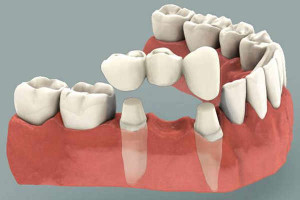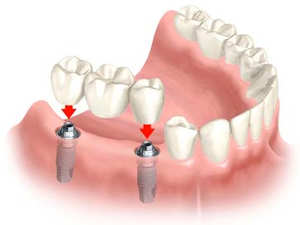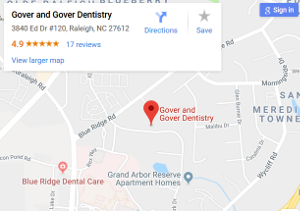Have you lost some of your teeth and feel it’s time to inquire about Dental Bridges? The good news is we can help you restore your oral health and get back your smile. At Gover and Gover Dentistry in Raleigh we routinely perform these restorative dental procedures with great success.
All of your teeth are important whether it’s for speaking, chewing and or just maintaining proper spacing and alignment of other teeth. Tooth loss doesn’t have to be part of the aging process, but if you do lose teeth, they must be replaced to maintain proper function of your mouth. Fortunately, there are several options for correcting tooth loss including dental bridgework.
Dental Bridges – A Good Solution for Tooth Loss
A dental bridge is simply a device used to replace missing teeth. It literally “bridges” the gap between missing teeth. It works by attaching artificial teeth, called pontics, to adjacent natural teeth, often referred to as abutment teeth. A bridge may also be attached to implants and in such a case is referred to as an “implant supported bridge.” Bridges are either permanently attached, known as fixed bridges, or they can be removable.
Dental bridges can be made exclusively, or from a combination, of porcelain, ceramic, non-precious metals or gold. The porcelain-fused-to-metal bridge (PFM Bridge) is generally considered stronger and more long-lasting than an all-porcelain bridge and is often preferred for fixed bridges on rear chewing teeth.
A dental bridge can replace a single tooth or multiple teeth, but there is a risk of compromising the integrity and strength of the dental bridge itself if spanning too great a distance. If a dental bridge has too many pontics, the normal bite force of the jaw could break the bridge. For this reason, it is often better to break up a larger space by using an implant for added strength.
Fixed bridges are applied by either placing crowns on the abutment teeth or onto implants or by bonding the artificial teeth directly to the abutment teeth. Removable bridges are attached to the teeth with metal clasps or by precision attachments.
If you are missing one or more teeth, you are probably aware of their importance to your appearance and dental health. Your teeth work together for many daily functions from eating to speaking. With missing teeth, it’s difficult to do these things. Missing teeth can and should be replaced and fortunately, fixed bridges are a great way to restore your dental health and appearance.
Fixed, Removable or Fixed Partial Denture?
A dental bridge is sometimes referred to as a fixed partial denture or FPD. Fixed bridges are bonded into place and can only be removed by a dental professional. Removable bridges, as the name suggests, can be taken out and cleaned. One advantage of fixed bridges is greater stability than their removable counterparts.
Why is a dental bridge a good idea?
Cosmetic appearance and oral functionality are important reasons for wearing a dental bridge. More than just replacing missing teeth, a bridge can provide necessary support for the lips and cheeks. For instance, the loss of a back tooth can literally cause your mouth to sink which in turn makes your face look older.
Ultimately dental health is the most important reason for a bridge. Teeth were designed to complement and support each other. A similar example might be the way in which the health of the feet and knees affect one’s gait. A foot problem or knee injury, particularly for a runner, can then lead to back problems and hip problems as unusual stresses move through the chain of motion. In the same fashion, unusual stresses are placed on the gums and other oral tissues when teeth are missing, causing a number of potentially harmful disorders.
One of the worst side effects of missing teeth is increased risk of gum disease, but this can be minimized with a dental bridge.
Speech disorders can also be caused by missing teeth, as they are used to make many of the sounds we use to speak clearly.
How is a bridge attached?
The entire procedure usually requires multiple appointments to complete. The first appointment involves preparing the teeth on either side of the gap by removing a portion of the enamel and dentin. If these teeth are not healthy enough to support the bridge or if several teeth are missing, it may be necessary to install implants on which the bridge can be attached. This is a more-involved procedure and will lengthen the overall process as healing time is required for the implants.
It is critical that the bridge be fabricated very precisely to ensure correct bite and to match the opposing teeth. To ensure the accuracy of these dimensions, impressions of the teeth are taken and sent to a lab where the bridge will be constructed.
Fixed bridges are typically cemented to the natural teeth next to the space left by the missing tooth. A pontic (false tooth) replaces the lost tooth. Crowns, which are cemented onto the adjacent natural teeth, provide the support for the bridge.
What materials are used?
Bridges can be constructed from gold alloys, non-precious alloys, porcelain, or a combination of these materials. Porcelain is often bonded to either precious or non-precious metal.
How do you take care of dental bridges?
Dental bridges do not last forever but a strict regimen of brushing and flossing will keep your dental bridges and surrounding teeth clean for the longest possible time. This is of critical importance as dental bridges rely on the neighboring teeth for support.


